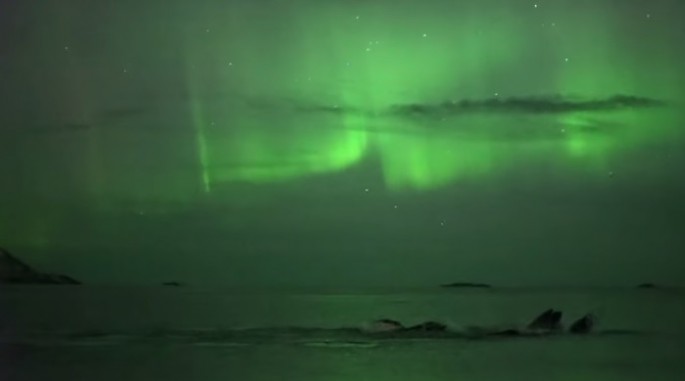A group of humpback whales was captured on video revealing stunning footage of the creatures hunting for herring in the ocean under the vivid colors of northern lights, by a local journalist in Norway.
A professional photographer from the Norwegian Public Broadcasting, Harald Albrigtsen, was lucky enough to capture the event during equipment testing of a special camera that is capable of documenting footage in dark conditions without losing any details of an image, all in high definition.
During a recent interview with local media, Albrigtsen recounted how he discovered these humpback whales while conducting tests for his camera equipment when he noticed how the marine mammals seem to be playing with one another under the aurora borealis lights.
The next day, the photographer decided to visit the exact spot if he can approach closer to the whales when the animals turned up when he was about to give up searching for them.
The spectacular video were taken from the coast of Kvaløya which is near the city of Tromsø in Norway. The name Kvaløya means "Whale Island" which is a sacred place to honor whales that regularly visit the region to hunt for food and relax, basking and playing with one another.
The whales appear to be magical, while basking under these northern lights. This natural atmospheric event is also known as aurora borealis where these bright lights up in the sky can be regularly spotted in the northern hemisphere of the planet. The southern hemisphere also have these bright lights at night called the aurora australis.
These lights are named after mythological deities, Aurora, who is the goddess of dawn in Roman mythology and Boreas, the god of the North Wind from Greek lore, by the famous Italian astronomer, Galileo.
These auroras occur when powerful solar activity called coronal mass ejections hit the Earth's magnetic field, where this ejection in the form of a gas cloud transforms Earth's atmosphere into an array of beautiful night lights in a span of two to three days.
This collision creates highly charged particle currents in the sky, flowing along with magnetic force lines in the polar regions. When these charged particles comes into contact with the existing oxygen and nitrogen particles in the atmosphere, this results in a spectacular prism of colors from emerald green hues.



























